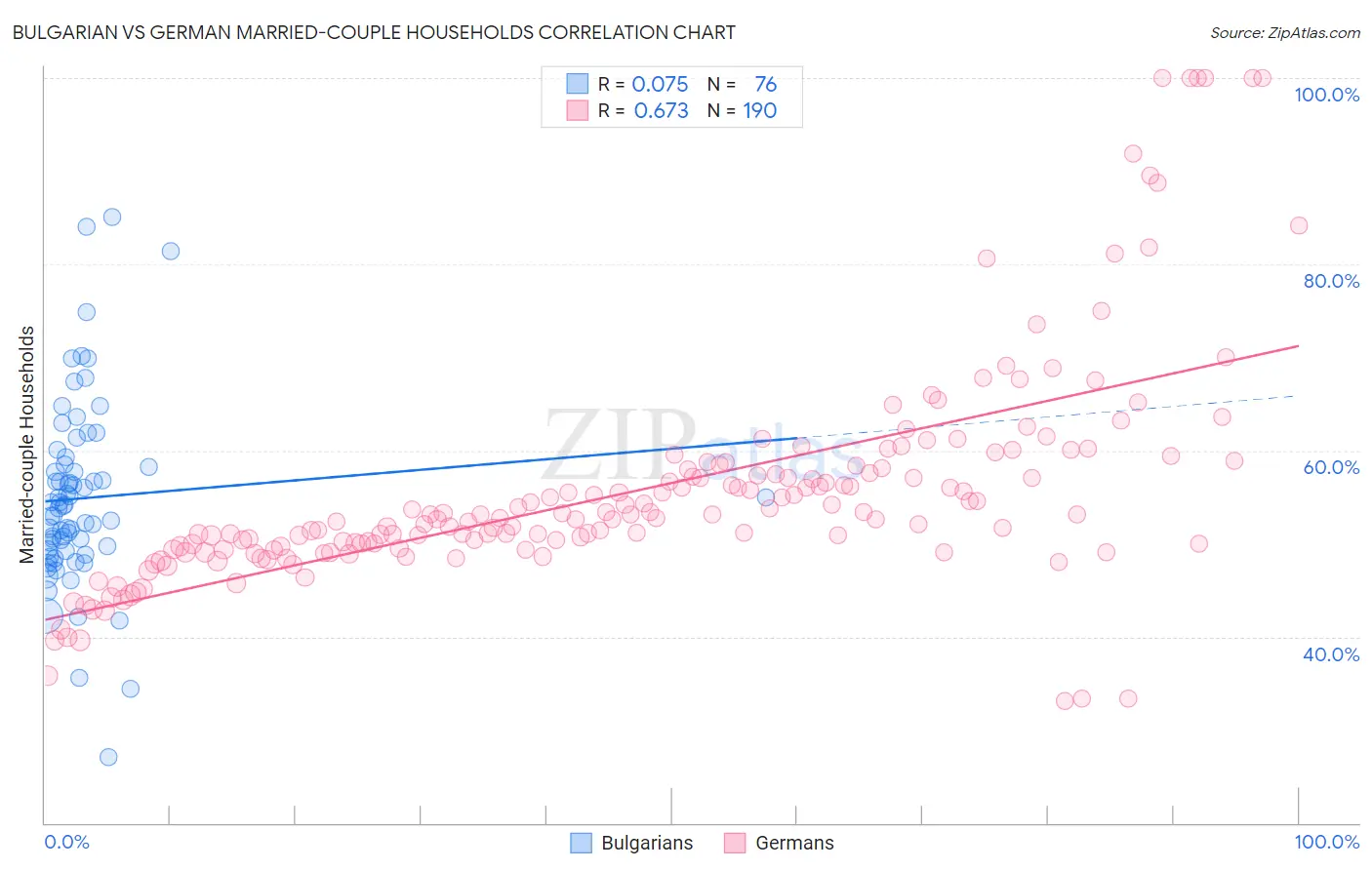Bulgarian vs German Married-couple Households
COMPARE
Bulgarian
German
Married-couple Households
Married-couple Households Comparison
Bulgarians
Germans
48.5%
MARRIED-COUPLE HOUSEHOLDS
99.1/ 100
METRIC RATING
61st/ 347
METRIC RANK
49.2%
MARRIED-COUPLE HOUSEHOLDS
99.8/ 100
METRIC RATING
28th/ 347
METRIC RANK
Bulgarian vs German Married-couple Households Correlation Chart
The statistical analysis conducted on geographies consisting of 205,562,211 people shows a slight positive correlation between the proportion of Bulgarians and percentage of married-couple family households in the United States with a correlation coefficient (R) of 0.075 and weighted average of 48.5%. Similarly, the statistical analysis conducted on geographies consisting of 580,558,752 people shows a significant positive correlation between the proportion of Germans and percentage of married-couple family households in the United States with a correlation coefficient (R) of 0.673 and weighted average of 49.2%, a difference of 1.4%.

Married-couple Households Correlation Summary
| Measurement | Bulgarian | German |
| Minimum | 27.1% | 33.1% |
| Maximum | 85.1% | 100.0% |
| Range | 58.0% | 66.9% |
| Mean | 54.9% | 55.8% |
| Median | 53.9% | 53.1% |
| Interquartile 25% (IQ1) | 49.2% | 49.7% |
| Interquartile 75% (IQ3) | 58.4% | 58.1% |
| Interquartile Range (IQR) | 9.1% | 8.4% |
| Standard Deviation (Sample) | 10.0% | 12.1% |
| Standard Deviation (Population) | 9.9% | 12.1% |
Similar Demographics by Married-couple Households
Demographics Similar to Bulgarians by Married-couple Households
In terms of married-couple households, the demographic groups most similar to Bulgarians are Luxembourger (48.5%, a difference of 0.0%), Croatian (48.5%, a difference of 0.050%), Basque (48.4%, a difference of 0.070%), Northern European (48.4%, a difference of 0.080%), and Immigrants from Canada (48.4%, a difference of 0.10%).
| Demographics | Rating | Rank | Married-couple Households |
| Immigrants | Lithuania | 99.3 /100 | #54 | Exceptional 48.6% |
| Austrians | 99.3 /100 | #55 | Exceptional 48.6% |
| Immigrants | Northern Europe | 99.3 /100 | #56 | Exceptional 48.6% |
| Poles | 99.2 /100 | #57 | Exceptional 48.5% |
| Immigrants | Indonesia | 99.2 /100 | #58 | Exceptional 48.5% |
| Czechoslovakians | 99.2 /100 | #59 | Exceptional 48.5% |
| Croatians | 99.1 /100 | #60 | Exceptional 48.5% |
| Bulgarians | 99.1 /100 | #61 | Exceptional 48.5% |
| Luxembourgers | 99.1 /100 | #62 | Exceptional 48.5% |
| Basques | 99.0 /100 | #63 | Exceptional 48.4% |
| Northern Europeans | 99.0 /100 | #64 | Exceptional 48.4% |
| Immigrants | Canada | 99.0 /100 | #65 | Exceptional 48.4% |
| Jordanians | 98.9 /100 | #66 | Exceptional 48.4% |
| Romanians | 98.9 /100 | #67 | Exceptional 48.4% |
| Immigrants | South Eastern Asia | 98.9 /100 | #68 | Exceptional 48.4% |
Demographics Similar to Germans by Married-couple Households
In terms of married-couple households, the demographic groups most similar to Germans are Maltese (49.2%, a difference of 0.010%), Bolivian (49.2%, a difference of 0.020%), Native Hawaiian (49.1%, a difference of 0.13%), Bhutanese (49.3%, a difference of 0.19%), and Hungarian (49.1%, a difference of 0.19%).
| Demographics | Rating | Rank | Married-couple Households |
| Norwegians | 99.9 /100 | #21 | Exceptional 49.5% |
| Asians | 99.9 /100 | #22 | Exceptional 49.5% |
| Dutch | 99.9 /100 | #23 | Exceptional 49.5% |
| Czechs | 99.9 /100 | #24 | Exceptional 49.4% |
| Immigrants | Philippines | 99.9 /100 | #25 | Exceptional 49.3% |
| Immigrants | Scotland | 99.8 /100 | #26 | Exceptional 49.3% |
| Bhutanese | 99.8 /100 | #27 | Exceptional 49.3% |
| Germans | 99.8 /100 | #28 | Exceptional 49.2% |
| Maltese | 99.8 /100 | #29 | Exceptional 49.2% |
| Bolivians | 99.8 /100 | #30 | Exceptional 49.2% |
| Native Hawaiians | 99.8 /100 | #31 | Exceptional 49.1% |
| Hungarians | 99.8 /100 | #32 | Exceptional 49.1% |
| Immigrants | Asia | 99.7 /100 | #33 | Exceptional 49.1% |
| Italians | 99.7 /100 | #34 | Exceptional 49.0% |
| Scottish | 99.7 /100 | #35 | Exceptional 49.0% |